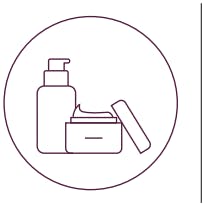C/ Improving the environmental profile of packaging, new displays and Free-Standing stores in accordance with the Group’s sustainable development principles
Packaging represents a significant part of the environmental impact of cosmetic products. The reduction in the environmental footprint of packaging is therefore naturally part of the commitments under the new L’Oréal for the Future programme, following on from the former Sharing Beauty With All programme, which came to an end in 2020.
In 2007, L’Oréal launched a Packaging and the Environment Policy that incorporates respect for consumers, the environment and biodiversity.
The new programme highlights three major challenges to improving the environmental profile of packaging:
- Reduce: designing filling and packing articles and finished goods that are smaller and lighter in relation to the contents, thereby consuming fewer resources;
- Replace: substituting high-impact materials with alternative materials with lower environmental footprints, such as recycled materials and materials from natural and renewable sources; and
- Recycle: making sure that the packaging can contribute to circularity by being recycled.
These principles are applied well ahead of each launch, right from the marketing brief, and are orchestrated via a global, systematic eco-design process for the Group’s packaging, notably with the help of the SPOT measurement tool and methodology. L’Oréal’s sustainable development commitments are an integral part of the Group’s packaging strategy and new tools are have been rolled out for use by the product development teams.
Since 2018, the Group has used a specific POS programme that is based on the principles of eco-design and the circular economics. In addition, for our Free Standing Stores, we have drawn up an eco-design and construction guide in line with our principles of sustainable development. The Group shares the guidelines and best practices for both these initiatives with its suppliers and partner distributors.

In 2021, 78% of created or renovated products had an improved environmental profile due to improved packaging.
Materials vigilance and preservation of resources
L’Oréal requires a food-grade level for all materials used in its packaging that is in contact with its products. The Group also takes a proactive approach with its suppliers in order to ensure that packaging does not contain any sensitive substances. Audits are conducted regularly to ensure the conformity of the filling and packing components delivered, thus ensuring an uncompromised level of quality and safety for consumers.
L’Oréal has pledged that it will no longer produce finished products containing PVC. This commitment has been kept since 1 January 2018, with the exception of recent acquisitions, no PVC packaging has been used in the manufacture of finished products since that date.
Controlling the source of materials used in packaging is a major challenge that requires responsible sourcing. L’Oréal has set itself the target of using, for its paper, cardboard or wooden packaging, materials from sustainably managed forests, exploited with respect for populations and forest ecosystems. The paper and cardboard used for packaging come from forests that are FSC preferably or PEFC certified (or have obtained any other certification recognised by PEFC International). Since 2010, L’Oréal has been a member of the Forest Stewardship Council (FSC) in France and the FSC label is the only one claimed on paper or cardboard packaging for the Group’s products.
In 2021, 100% of the paper used for product leaflets and 99.9% of the cardboard used for folding boxes for finished goods were certified as coming from sustainably managed forests.
As part of its new Forest 2030 Policy, L'Oréal is expanding its goals to move beyond certification of the material, while extending its scope of application to cover the Group’s primary, secondary and tertiary packaging. In an approach to achieve continuous improvement in traceability, L’Oréal has made a commitment that, by 2030, 100% of its packaging biomaterials will be traceable and come from sustainable sources, with no connection to deforestation. To do so, the Group will rely on the Chain of Custody certification of its packaging suppliers, enhanced by knowledge about their supplies’ countries of origin (production sites of the material, origin of fibres).
Finally, with the aim of improving the recycling of the products put on the market, the Group’s brands have worked to provide consumers with detailed sorting instructions and to design packaging that is at most compatible with existing sorting and recycling streams, eliminating disruptors and thereby promoting material recovery after use of the product, to participate in the circular economy.
In addition, several brands sold by L’Oréal in France (Cadum, Garnier, L’Oréal Paris, Narta, Ushuaïa, Vichy, and others), in partnership with the eco-organism CITEO, are pursuing a sorting awareness campaign (media, advertising, etc.) via the “Trionsenbeaute.fr” platform, designed to support consumers in their process to sort their beauty products at the end of life.
